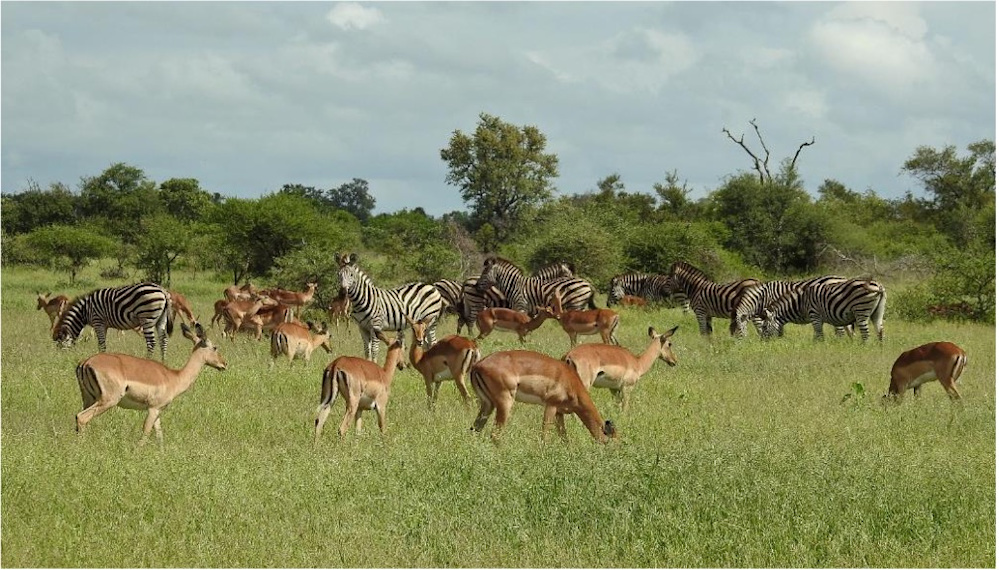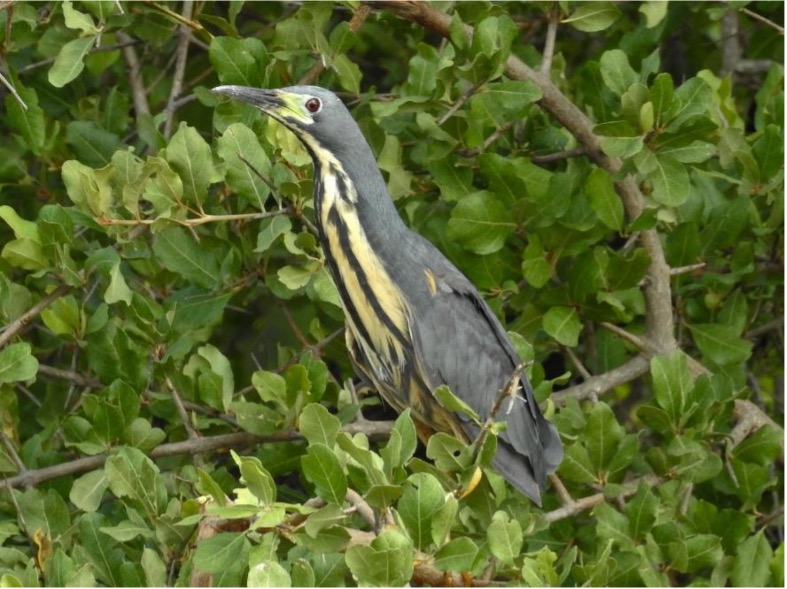January 2021
Singita Kruger National Park: January 2021
Share:
Singita Kruger National Park: January 2021
The great rains that we have received this month have increased the water levels across our concession. The pans that once could only accommodate a wallowing warthog have swelled in width and depth and are now inviting the grey giants like rhino and elephants to step in for a wallow. The N’wanetsi and Sweni Rivers both came down in flood on the 25th of January, following three days of heavy rainfall.
The bush is radiantly green and lush, capable of concealing a herd of elephants. The fruiting trees are bearing the fruits of their awaited seeds, using the animals and some peckish humans to disperse the seeds across the property. The white berry bush is doing particularly well looking like decorated Christmas trees in almost every corner, some of the marula trees have already begun fruiting and have even begun to drop their flavourful fruits on the ground. As a result of the provision of the rain to the thirsty grounds and vegetation, the herbivores are in pristine condition, sporting glowing healthy coats, that shimmer as the light falls on them.
Here’s a Sightings Snapshot for January:
Lions
- Two nomadic males have been seen wandering around our most northern border.
- The lone survivor of the coalition called the Kumana Males has been seen around the southern parts of our concession, sporting injuries around his face and legs, that could be from defending his territory from encroaching males or possibly from prey that put up a fight.
- Shish Pride has been seen slowly moving closer and closer to our western border.
- The Mountain Pride was by far the most viewed pride this month, and have been sighted in the central parts of the concession with their young cubs in good condition.
- A lioness was seen with a newly born cub on Park Road, we are not too sure of her pride.
- A lone nomadic male was seen on multiple occasions on our concession.
- Xihamham was seen in good condition on the concession, but his brothers were nowhere to be seen.
Leopards
- A possible mating pair of leopards were seen on the concession lying a few paws apart.
- A female leopard (possibly the Nhlangulene Female) and her cub were found near the Nhlangulene valley.
- The “Mbiri-mbiri” young male with two spots on both sides of his nose has been seen on several occasions in the region of Pony Pan and the Central Depression. He is very relaxed with the vehicles and we are hoping that he will establish his territory in our area.
- Late in the month two leopards were seen near the Quarry site close to our western border. They were seen in the same area for a few days and, although we did not find the kill, we assume that they had a carcass hidden there somewhere.
- A large male leopard was seen on at least two occasions near the camp. We have also heard antelope alarm calls coming from the riverine vegetation nearby Sweni Camp, and therefore assume that this male leopard has frequently been in the area this last month.
Cheetahs
- We have had one sighting of cheetahs in the concession this last month. Towards the end of the first week we located three cheetahs in the grasslands in the far north of the concession. It is not really surprising that we have not been seeing many cheetahs as the grass is very long now and is not conducive for cheetahs to hunt.
Spotted Hyenas
- We have seen spotted hyenas on a few occasions. They can be seen anywhere in the concession and wander long distances at night. We are not aware of any active den sites in the area at present.
- Towards the end of the month a leopard was found with a carcass of an impala cached in a leadwood tree. Three Spotted Hyenas then appeared, hoping to get some scraps or hoping that the carcass would fall down. A second leopard appeared at the scene and the hyenas thought that they might get lucky and that the impala might get knocked down. The original leopard harassed the hyenas on a few occasions, but it got dark and the sighting was left with the leopards in the tree and the hyenas at the base.
Elephants
- Elephants have been seen regularly this last month, although the numbers have not been high. At this time of the year the marula trees are coming in to fruit and the elephants love to feed on these delicious treats. Since marula trees are much more common in the western half of the Kruger National Park (where the soil is more sandy) the elephants tend to move towards those areas. We will expect to see more elephants in the concession again when the marula fruiting season is over.
Buffalos
- The lush green grass has attracted quite a few buffalos into the area. In the northern part of the concession, where we have extensive grassland areas, we have been seeing a large herd of over three hundred individuals.
- We have also seen various groups of dagga boys (bachelor herds) throughout the concession. A particular group of four bulls has been seen on a few occasions between James Road and Dave’s Crossing, fairly close to camp. Another group of bulls has been seen on a few occasions enjoying the cool, muddy water at Schotia Pan. Warthog Pan, in the central Depression, has also attracted a few bulls to come and drink and wallow.
Plains game
- Although the bush is thick and the grass is long we have still been seeing good numbers of general game including wildebeest, zebras, giraffe, kudus, impalas, and waterbuck. There are a few areas in the concession that have been consistently attracting large accumulations of these animals this last month. Some of these areas include the “N4 open area”, “Ostrich Open Area”, “Gudzani Loop”, “Border 4-ways”and “Milkberry Ridge”.
- We have noticed that the numbers of warthogs have increased in the concession, in comparison to the numbers that we saw during the years of drought that we recently experienced. These animals are very comical and are a guest favourite (particularly since Pumba was such an important character in the Lion King movies and plays).

Rare animals and other sightings
- We have been very fortunate to have had a few sightings of African wild dogs / painted wolves in the concession this last month. There appears to be a pack of six dogs that seem to have taken up a home-range in the area to the south of the lodges and they have been seen hunting in the area close to the lodges on at least four occasions. This is very exciting for us as this area is not an area that is generally known for wild dog sightings. These creatures are extremely rare and are listed as ‘Critically Endangered’ as a species by the I.U.C.N. (International Union for the Conservation of Nature). We are hoping that this pack will take up permanent residence in the area.
- We have had a few sightings of the diminutive Sharpe’s grysbok in the hilly areas of the concession this last month. These are uncommon antelopes. We generally see these antelope more often in the winter months when the grass is not as long.
- We had a sighting of a serval in the grasslands near Basalt Road. Serval are long-legged, spotted cats that look similar to smaller versions of cheetahs. They tend to be nocturnal.
- We also had a sighting of an African wild cat near Basalt Road this last month.
- One afternoon we were lucky enough to see a caracal. As it saw us it quickly hid in some bushes at the side of the road. We turned off the car engine and after a short while the caracal came strolling out onto the road in front of us and then crossed, giving us some amazing views of a typically very secretive cat.
Birds
- Summer is in full swing now and all the palearctic and intra-African migrants are all back. It is at this time of the year that we have the greatest diversity of species in the area. This last month we saw 218 species of birds in the concession.
- Some of the special birds seen this last month include: dwarf bittern, lappet-faced vulture, white-headed vulture, long-crested eagle, martial eagle, African crake, lesser moorhen, kori bustard, greater painted-snipe, African pygmy-kingfisher, southern ground-hornbill, eastern nicator and yellow-billed oxpecker.

Dwarf bittern. Photo by Brian Rode.
type: asset-hyperlink id: 44DJfrQtVECas54Ad1hjph

By Jenny Hishin
Author / Field Guide